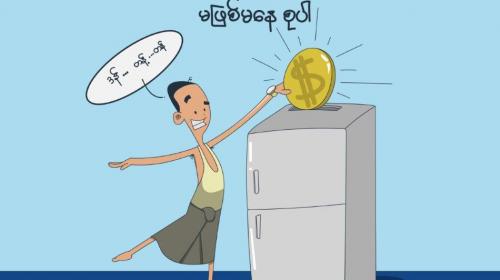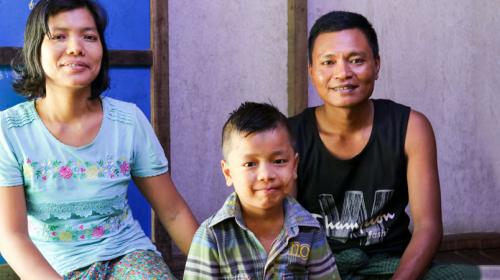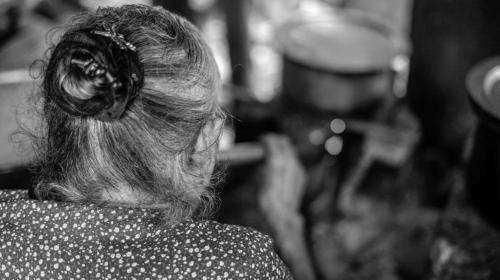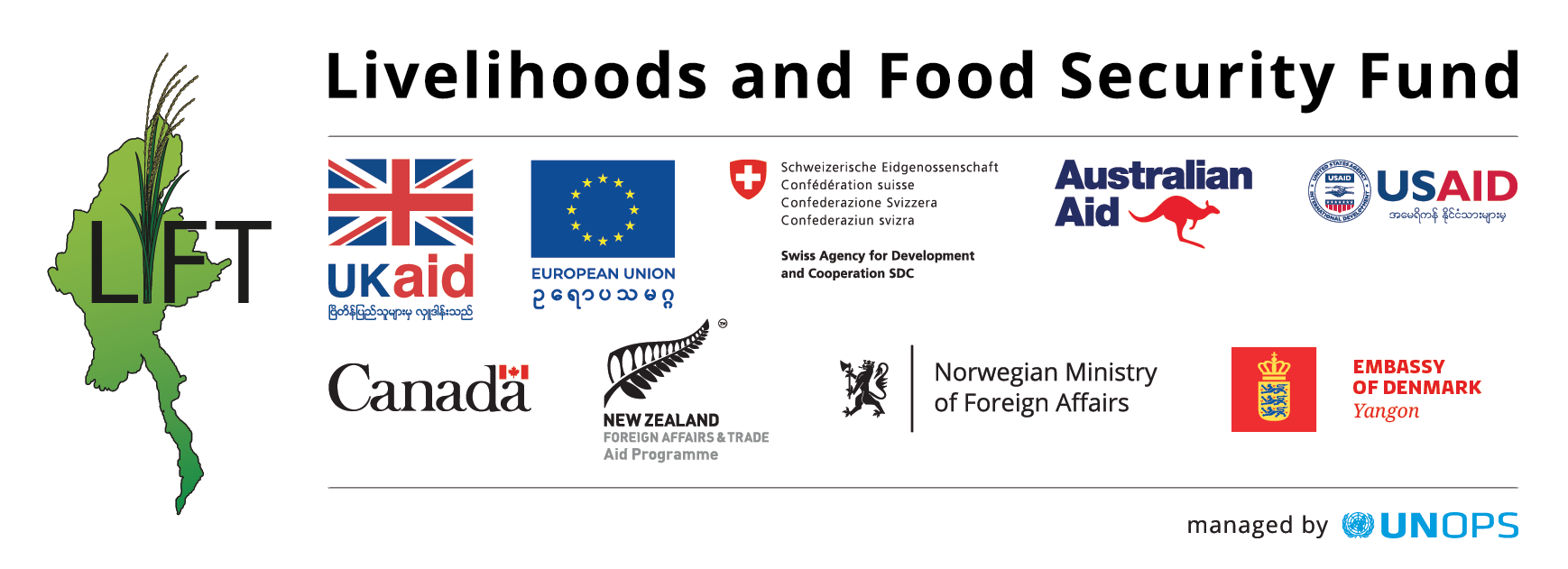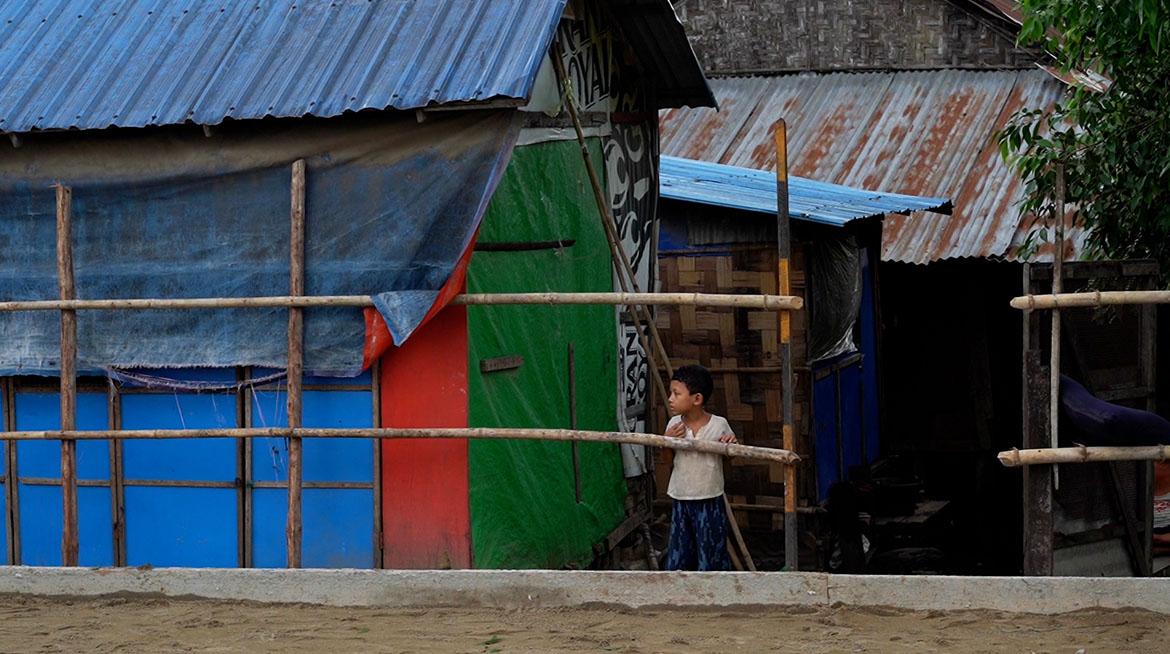
The first wave of COVID-19 disruptions in early 2020 resulted in a sharp increase in poverty, but the much stronger second wave has hit even harder. A new study from the International Food Policy Research Institute (IFPRI) reports evidence form urban Yangon and the rural dry zone that exposes a shocking increase in poverty, while their simulation analysis projects further misery in 2021 unless social protection can be scaled up. While the lockdowns are an effective measure to prevent the spread of the disease, both survey and simulation evidence point to their disastrous impact on income and livelihoods for the poor, particularly in urban areas. Stay-at-home orders need to go hand in hand with larger cash transfers that reach the very poorest during the crisis.
Poverty and food insecurity in 2020
Income-based poverty increased sharply between January and June during the first wave of COVID-19, particularly in urban areas. While things then improved briefly, the second wave and associated prevention measures have hit households especially hard. A shocking 35 per cent of households earned no income at all in September, and this remained at 30 per cent in October. More than half of households with young children or pregnant women in urban Yangon and the rural Dry Zone fell below the $1.90 per day international poverty line. In particular, 59 per cent of the Yangon sample (up from just 7 per cent in January) and 65 per cent of the rural sample (up from 25 per cent in January) are making less than MMK 890, or USD 1.90, per person per day. Along with rising rates of household poverty, mothers in these households are now experiencing food insecurity and inadequate dietary diversity, especially in urban areas. In June, 30 per cent of Yangon mothers had inadequately diverse diets, but in October, 49 per cent of urban mothers did not eat a varied diet, hurting their own and their children’s nutrition.
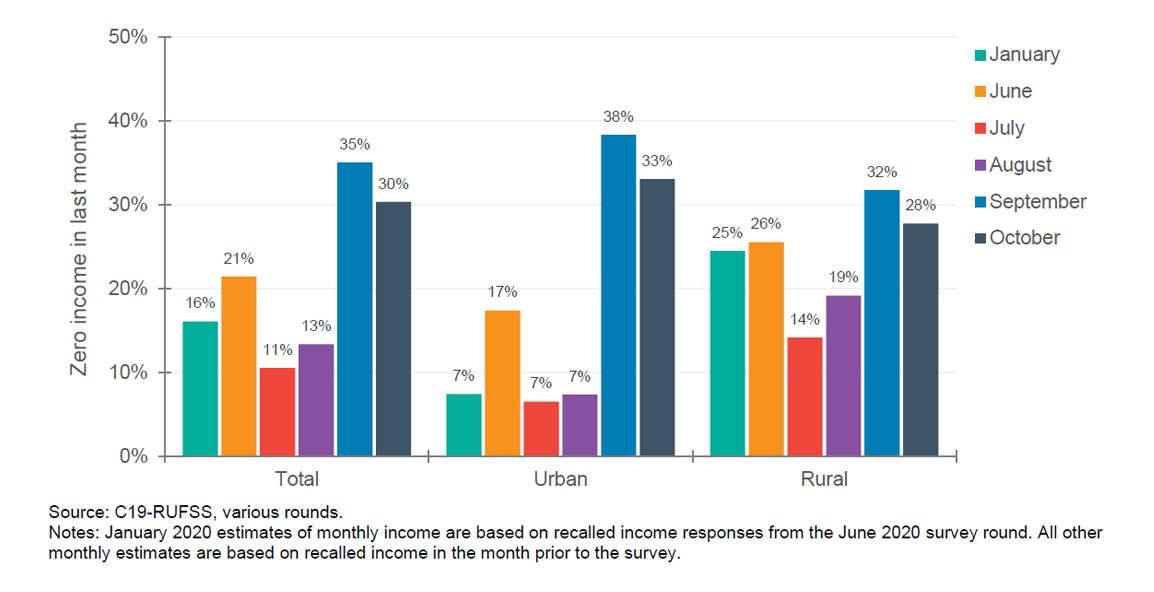 What to expect in 2021?
What to expect in 2021?
The Government’s support of MMK 20,000 per household has aimed to alleviate this strain, but will these transfers be sufficient to stem the tide of rising poverty? IFPRI’s survey evidence shows that many poor people are not yet receiving the help they need. IFPRI found that only 49.6 per cent of the very poorest (those making MMK 890 or less a day) received the cash transfer, and yet 36.1 per cent of the people above this poverty line received the cash. According to IFPRI’s simulations, the most crucial action is to 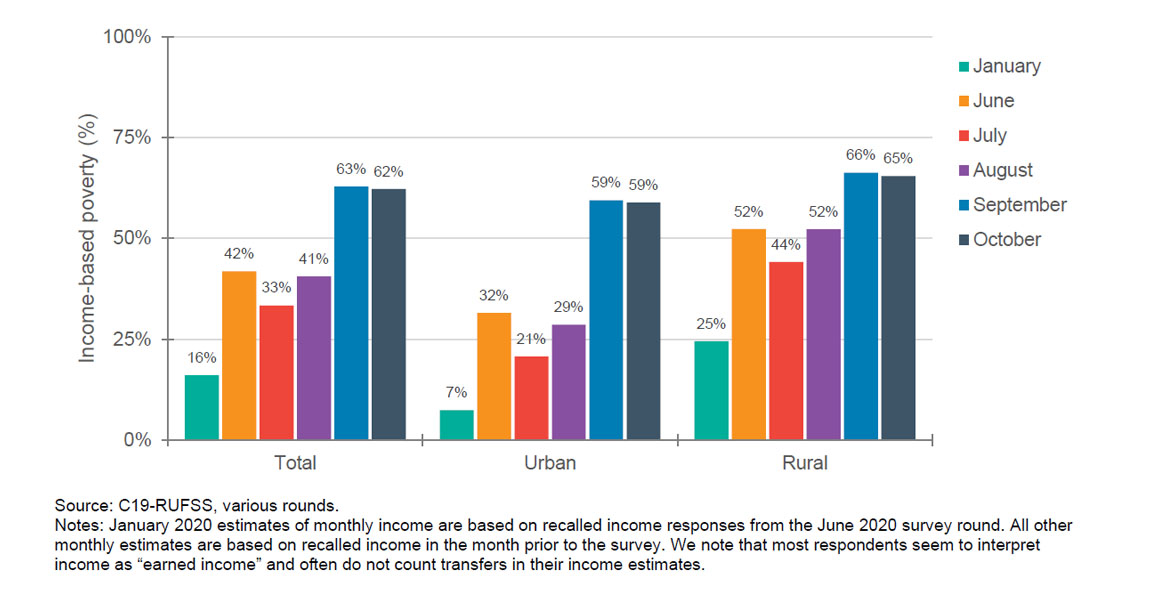 provide more financial assistance to households during lockdown periods, when poverty rates rise dramatically. They show that MMK 20,000 in cash transfers can make a moderate difference (reducing the poverty rate by 4.7 percentage points with accurate targeting) but much larger transfers are needed to make a sizable dent in the national poverty rate. For example, an accurately targeted MMK 60,000 social protection payment would cut the poverty rate during lockdowns by half.
provide more financial assistance to households during lockdown periods, when poverty rates rise dramatically. They show that MMK 20,000 in cash transfers can make a moderate difference (reducing the poverty rate by 4.7 percentage points with accurate targeting) but much larger transfers are needed to make a sizable dent in the national poverty rate. For example, an accurately targeted MMK 60,000 social protection payment would cut the poverty rate during lockdowns by half.
What is needed?
The results suggest that a more flexible and ambitious social protection strategy may be needed during the COVID-19 crisis. Larger cash transfers during lockdowns will be required if households cannot earn an income. More generous transfers might also improve adherence to these orders, thus curbing the spread of the disease. Scaling up cash transfers is no easy task, of course, requiring the fiscal space as well as the capacity, personnel and adequate monitoring arrangements. Cash-for-work programmes can also help those in need to recover whilst building up community infrastructure.
A balance between lives and livelihoods for the poorest, however, must be at the core of the response to the crisis. Without these urgent steps, Myanmar’s second wave of poverty could become a tsunami of misery.
The article builds upon IFPRI’s paper ‘Poverty, food insecurity, and social protection during COVID-19 in Myanmar’ by Derek Headey, Than Zaw Oo, Kristi Mahrt, Xinshen Diao, Sophie Goudet, and Isabel Lambrecht. Read this article in Myanmar language below.
.................................
မြန်မာ - လှိုင်းထလာသော ရောဂါများ နှင့် အတူ လိုက်ပါ မြင့်တက်လာသည့် ဆင်းရဲနွမ်းပါးမှု
၂၀၂၀ခုနှစ်အစောပိုင်းက ကိုဗစ်နိုင်တင်း ပထမလှိုင်း၏ ရိုက်ခတ်မှုများကြောင့် ဆင်းရဲနွမ်းပါးမှုမှာ လည်း သိသိသာသာ မြင့်တက်လာခဲ့ပါသည်။ ဒုတိယလှိုင်း၏ ရိုက်ခတ်မှုက ပို၍ပင် ပြင်းထန်လာခဲ့ သည်။ International Food Policy Research Institute (IFPRI) ၏ လေ့လာမှုအသစ်တွင် ရန်ကုန်၏ မြို့ပြဒေသများနှင့် အပူပိုင်းဇုန် ကျေးလက်ဒေတို့တွင် ဆင်းရဲနွမ်းပါးမှုမြင့်မားလာမှုမှာ ထိတ်လန့်ဖွယ်အနေအထားရှိနေသည်ဟု အစီရင်ခံထားသည်။ IFPRI ၏ simulation analysis (မျှော်မှန်းရလဒ်များကို တွက်ချက်သည့် နည်းလမ်း) စီမံချက်များအရဆိုလျှင် လူမှုကာကွယ် စောင့်ရှောက်ရေးလုပ်ငန်းများကို တိုးမြှင့်ဆောင်ရွက်နိုင်ခြင်းမရှိပါက လာမည့် ၂၀၂၁ခုနှစ်တွင် ပို၍ပင် အားရစရာမရှိလှဟု ဖော်ထုတ်ထားသည်။ အသွားအလာကန့်သတ်ခြင်းများသည် ရောဂါကူးစက် ပြန့်ပွားမှုကို ထိန်းချုပ်ရာတွင် ထိရောက်သည့် နည်းလမ်းတစ်ခုဖြစ်သော်လည်း ၎င်းကန့်သန့်မှုများ သည် အခြေခံလူတန်းစားများ၏ စားဝတ်နေရေးရပ်တည်နေရမှုများနှင့် ဝင်ငွေအပေါ်တွင် အလွန် ထိခိုက်မှုများရှိကြောင်းကို စစ်တမ်းနှင့် တွက်ချက်မှုများအရ တွေ့ရှိရသည်။ အကျပ်အတည်းကာလ အတွင်း အိမ်မှာနေထိုင်ရေး ညွှန်ကြားချက်များနှင့် အနွမ်းပါးဆုံး အခြေခံလူတန်းစားများကို ငွေကြေးထောက်ပံ့မှုများသည် ချိတ်ဆက်ဆောင်ရွက်ရန်လိုအပ်ပါသည်။
၂၀၂၀ခုနှစ်အတွင်း ဆင်းရဲနွမ်းပါးမှုနှင့် စားနပ်ရိက္ခာမဖူလုံမှု
ဝင်ငွေမရှိတော့ခြင်းကြောင့် စားဝတ်နေရေးခက်ခဲလာမှုသည် ကိုဗစ်ပထမလှိုင်းဖြစ်ပွားသည့် ဇန်နဝါရီလမှ ဇွန်လအတွင်း အထူးသဖြင့် မြို့ပြဒေသများတွင် သိသိသာသာမြင့်တက်လာသည်။ ထို့နောက် အခြေအနေ အနည်းအကျဉ်းတိုးတက်လာသော်လည်း ဒုတိယလှိုင်းဖြစ်ပွားမှုနှင့် ဆက်စပ်ဆောင်ရွက်ရသည့် ထိန်းချုပ်မှုများသည် ခက်ခဲစွာ ရုန်းကန်နေရသည့် အိမ်ထောင်စုများ အပေါ် ရိုက်ခတ်လာတော့သည်။ အိမ်ထောင်စု ၃၅ရာခိုင်နှုန်းက စက်တင်ဘာလတွင် ဝင်ငွေတစ်ပြားမှ မရှိကြောင်းကို ဖြေကြားခဲ့ကြပြီး ထိုအခြေအနေမှာ အောက်တိုဘာလတွင် ၃၀ရာခိုင်နှုန်း ရှိသည်။ အပူပိုင်းဇုန် ကျေးလက်ဒေသများနှင့် ရန်ကုန်မြို့ပြဒေသများရှိ ကလေးငယ်များ သို့မဟုတ် ကိုယ်ဝန်ဆောင် ရှိသော အိမ်ထောင်စုများ၏ ထက်ဝက်ကျော်သည် နိုင်ငံတကာက သတ်မှတ် ထားသည့် ဆင်းရဲနွမ်းပါးမှုစံနှုန်း တစ်နေ့လျှင် အမေရိကန်ဒေါ်လာ ၁.၉၀ အောက်တွင် ရောက်ရှိ နေသည်။ ရန်ကုန်တွင် ကောက်ယူခဲ့သည့် အိမ်ထောင်စုများ၏ ၅၉ရာခိုင်နှုန်း (ဇန်နဝါရီတွင် ၇ရာခိုင်နှုန်းရှိခဲ့ရာမှ) နှင့် ကျေးလက်ကောက်ယူမှု၏ ၆၅ရာခိုင်နှုန်း (ဇန်နဝါရီတွင် ၂၅ရာခိုင်နှုန်း ရှိခဲ့ရာမှ) တို့သည် တစ်ရက်လျှင် မြန်မာငွေ ၈၉၀ ကျပ်(သို့မဟုတ်) အမေရိကန်ဒေါ်လာ ၁.၉၀ ထက် နည်းသည့် ဝင်ငွေသာရှိခဲ့သည်။ အိမ်ထောင်စုများ၏ နွမ်းပါးမှုမြင့်တက်လာသည်နှင့်အမျှ ယင်းအိမ်ထောင်စုများရှိ မိခင်များသည် စားနပ်ရိက္ခာမဖူလုံမှု၊ အစားအစာအမည်စုံ ဖူလုံစွာ မရရှိမှုကို ရင်ဆိုင်နေရသည်။ အထူးသဖြင့် မြို့ပြနေရာများတွင် ဖြစ်သည်။ ဇွန်လတွင် ရန်ကုန်ရှိ မိခင်များ၏ ၃၀ရာခိုင်နှန်းသည် အစားအစာအမျိုးအမည်စုံ ဖူလုံစွာ မစားသုံးခြင်းကို လေ့လာခဲ့ရသည်။ သိုသော်လည်း အောက်တိုဘာလတွင် ၄၉ရာခိုင်နှုန်းထိရှိလာခဲ့ရာ အဆိုပါ အခြေအနေသည် ၎င်းတို့ကိုယ်တိုင်အတွက်သာမက ၎င်းတို့ ရင်သွေးများ၏ အာဟာရကိုပါ ထိခိုက်မှုရှိလာသည်။
၂၀၂၁ တွင် ဘာတွေ မျှော်လင့်ထားနိုင်မလဲ?
အစိုးရမှ ထောက်ပံ့ပေးသည့် တစ်အိမ်ထောင်လျှင် ၂၀,၀၀၀ ကျပ်သည် အခက်အခဲများကို လျော့ပါး စေရန် ရည်ရွယ်ထားသော်လည်း အဆိုပါ ငွေကြေးထောက်ပံ့မှုများသည် မြင့်တက်လာနေသည့် ဆင်းရဲနွမ်းပါးမှုကို တောင့်ခံထားနိုင်ရန်အတွက် လုံလောက်နိုင်ပါမည်လားဟု စဉ်စားစရာရှိမည် ဖြစ်သည်။ IFPRI ၏ စစ်တမ်းအရဆိုလျှင် နွမ်းပါးသူ အများအပြားသည် လိုအပ်သောအကူအညီများ မရရှိကြသေးပေ။  ၈၉၀ကျပ် ထက် နည်းသည့် ဝင်ငွေသာ ရရှိသော အနွမ်းပါးဆုံးသောသူများ၏ ၄၉.၆ ရာခိုင်နှုန်းသာ ထောက်ပံ့ငွေကို ရရှိကြပြီး ထောက်ပံ့ငွေရရှိသော ကျန်သည့် ၃၆.၁ ရာခိုင်နှုန်း မှာ နွမ်းပါးမှုမျဉ်းအထက်တွင် ရှိနေသော သူများဖြစ်ကြကြောင်း IFPRI ၏ စစ်တမ်းမှ တွေ့ရှိခဲ့သည်။ IFPRI ၏ တွက်ချက်မှုများအရ ဆင်းရဲနွမ်းပါးမှု အခြေအနေ တဟုန်ထိုးမြင့်တက်နေသည့်အချိန် ဖြစ်သည့် အသွားအလာကန့်သတ်ထားသော အချိန်များတွင် အိမ်ထောင်စုများကို ငွေကြေး ထောက်ပံ့မှု ပိုမို လုပ်ဆောင်ရန်မှာ အရေးပါသည့် အချက်ဖြစ်သည်။ ထောက်ပံ့ငွေ ၂၀,၀၀၀ ကျပ်သည် နွမ်းပါးမှု အနေအထားကို အသင့်အတင့် အပြောင်းအလဲ (အတိအကျ ဆိုလျှင် နွမ်းပါးမှုနှုန်းကို အမှတ် ၄.၇ ရာခိုင်နှုန်းထိ လျှော့ချနိုင်) ဖြစ်စေသော်လည်း တစ်နိုင်ငံလုံးအတိုင်းအတာဖြင့် နွမ်းပါးမှု အနေအထား လျော့ကျစေရန်အတွက်မူ ထို့ထက်ပို၍ ထောက်ပံ့ပေးရန် လိုအပ်သည်။
၈၉၀ကျပ် ထက် နည်းသည့် ဝင်ငွေသာ ရရှိသော အနွမ်းပါးဆုံးသောသူများ၏ ၄၉.၆ ရာခိုင်နှုန်းသာ ထောက်ပံ့ငွေကို ရရှိကြပြီး ထောက်ပံ့ငွေရရှိသော ကျန်သည့် ၃၆.၁ ရာခိုင်နှုန်း မှာ နွမ်းပါးမှုမျဉ်းအထက်တွင် ရှိနေသော သူများဖြစ်ကြကြောင်း IFPRI ၏ စစ်တမ်းမှ တွေ့ရှိခဲ့သည်။ IFPRI ၏ တွက်ချက်မှုများအရ ဆင်းရဲနွမ်းပါးမှု အခြေအနေ တဟုန်ထိုးမြင့်တက်နေသည့်အချိန် ဖြစ်သည့် အသွားအလာကန့်သတ်ထားသော အချိန်များတွင် အိမ်ထောင်စုများကို ငွေကြေး ထောက်ပံ့မှု ပိုမို လုပ်ဆောင်ရန်မှာ အရေးပါသည့် အချက်ဖြစ်သည်။ ထောက်ပံ့ငွေ ၂၀,၀၀၀ ကျပ်သည် နွမ်းပါးမှု အနေအထားကို အသင့်အတင့် အပြောင်းအလဲ (အတိအကျ ဆိုလျှင် နွမ်းပါးမှုနှုန်းကို အမှတ် ၄.၇ ရာခိုင်နှုန်းထိ လျှော့ချနိုင်) ဖြစ်စေသော်လည်း တစ်နိုင်ငံလုံးအတိုင်းအတာဖြင့် နွမ်းပါးမှု အနေအထား လျော့ကျစေရန်အတွက်မူ ထို့ထက်ပို၍ ထောက်ပံ့ပေးရန် လိုအပ်သည်။  ဉပမာအားဖြင့် သတ်မှတ် အုပ်စုကို ပေးအပ်သည့် လူမှုကာကွယ်ရေး ထောက်ပံ့ငွေ ၆၀,၀၀၀ ကျပ်သည် လော့ဒေါင်း ကာလ အတွင်း နွမ်းပါးမှုကို ထက်ဝက်ထိ လျှော့ချနိုင်ပေလိမ့်မည် ဖြစ်သည်။
ဉပမာအားဖြင့် သတ်မှတ် အုပ်စုကို ပေးအပ်သည့် လူမှုကာကွယ်ရေး ထောက်ပံ့ငွေ ၆၀,၀၀၀ ကျပ်သည် လော့ဒေါင်း ကာလ အတွင်း နွမ်းပါးမှုကို ထက်ဝက်ထိ လျှော့ချနိုင်ပေလိမ့်မည် ဖြစ်သည်။
ဘာတွေလုပ်ဆောင်ရန်လိုလဲ?
တွေ့ရှိချက်များအရ ကိုဗစ်နိုင်တင်း အကျပ်အတည်း ကာလအတွင်း ပြောင်းလွယ် ပြင်လွယ်ရှိပြီး ပိုပြီးအလေးအနက်ထားဆောင်ရွက်မည့် လူမှုကာကွယ်စောင့်ရှောက်ရေး မဟာဗျူဟာ တစ်ခု လိုအပ်ကြောင်း အကြံပြုထားသည်။ အိမ်ထောင်စုများအနေဖြင့် ဝင်ငွေရလမ်းမရှိပါက လော့ဒေါင်း ကာလအတွင်း ပမာဏ ပိုမိုများပြားသည့် ငွေကြေးထောက်ပံ့မှုများ လိုအပ်ပါသည်။ အဆိုပါ ထောက်ပံ့မှုများသည် အသွားလာကန့်သတ်နေရသည့် ညွှန်ကြားချက်များကို ပိုမိုအသက်ဝင်စေမည် ဖြစ်ရာ ရောဂါ ကူးစက် မှု ကိုပါ ထိန်းချုပ်လာနိုင်မည် ဖြစ်သည်။ ငွေကြေးထောက်ပံ့မှုများကို တိုးမြှင့်လုပ်ဆောင်ရန်မှာ လွယ်ကူသည့် တာဝန်တော့ မဟုတ်ချေ။ ဘဏ္ဍာငွေ အပြင် လုပ်ဆောင် နိုင်သည့် အနေအထား၊ လူစွမ်းအား၊ ထိရောက်မှုတို့အတွက် တိုင်းတာနိုင်မည့် အစီအမံများ လိုအပ်သည်။ အလုပ်ပေးပြီး လုပ်အားအတွက် အခပေးသည့် အစီအစဉ်များဖြင့်လည်း အကျပ်အတည်း ကို ကျော်လွှားရာတွင် အထောက်အပံ့ဖြစ် နိုင်ပြီး တစ်ဖက်တွင်လည်း လူမှုအသိုက်အဝန်းအတွက် လိုအပ်သည့် အဆောက်အဦများတည်ဆောက်နိုင်မည် ဖြစ်သည်။
အနွမ်းပါးဆုံးသောသူများ၏ အသက်မွေးဝမ်းကျောင်းမှု နှင့် ရှင်သန်ရပ်တည်မှုအကြား ချိန်ခွင်လျှာ ညီမျှမှုသည် အကျပ်အတည်းကို တုံ့ပြန်ဆောင်ရွက်ရာတွင် အခရာကျလှသည်။ အဆိုပါ အရေးတကြီး လုပ်ဆောင်ရမည့် အဆင့်များမလုပ်ဆောင်ပါက မြန်မာနိုင်ငံ၏ ဆင်းရဲနွမ်းပါးမှု ဒုတိယလှိုင်းမှာ ဆူနာမီလှိုင်းပမာ ဖြစ်လာနိုင်ပေလိမ့်မည်။
ဤဆောင်းပါးကို IFPRI မှ ရေးသားထုတ်ဝေပြီး Derek Headey၊ သန်းဇော်ဦး၊ Kristi Mahrt၊ Xinshen Diao၊ Sophie Goudet၊ နှင့် Isabel Lambrecht တို့ ရေးသားထားသည့် “မြန်မာနိုင်ငံရှိ ကိုဗစ်နိုင်တင်းကာလအတွင်း ဆင်းရဲနွမ်းပါးမှု၊ စားနပ်ရိက္ခာ မဖူလုံမှု နှင့် လူမှုကာကွယ် စောင့်ရှောက် ရေး” စာတမ်းအပေါ် အခြေခံပြီး ရေးသားထားပါသည်။

